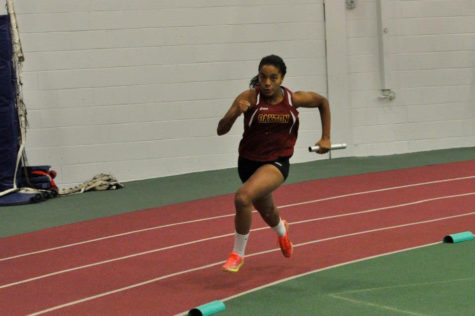Picking up the speed
How do student athletes prepare for the switch from the outdoors to an indoor track? When a student tries out for the cross country team, there’s a lot to expect. From pacing yourself to steady breathing, cross country seems to be easy if you’re a former long distance runner. There can also be different reasons for joining the team. Since cross country is about running for long times and distances, some sprinters and mid-distance runners choose to join the team in order to condition for indoor track.Though cross country and track and field both involve running, they are immensely different. Cross country is a team sport in which people run in open-air environments for lengthy times and distances, whereas Track and Field is solely based on skills of running along with field events. Track and field’s name comes from the sports venue: a stadium with an oval is the track and the grass inside the oval is the field where throwing occurs near the 400m track. There is also pole vault, high jump, and long jump, although the atmosphere is different in indoor track. The indoor track consists of a 200mtr track with the usual field events. The runners are still encouraged to run using the same tactics they would on a 400meter track, even though it’s a bit of a down size.
When it comes to both sports, the use of lower body muscles and the respiratory system team up to make the athlete accelerate and conquer the track or cross country course. Though in some cases the main components that ensure the athlete is up to par can easily be injured or fractured. The most common injuries ,as imagined, are sprained ankles, pulled muscles, shin spin, and runner’s knee. These are mostly preventable if the athlete stretches or is simply aware that they need to careful on the terrain. A repetitive injury in both sports are the tearing of the acl which is the act of the ligament twisting which results in an uncomfortable state of injury and pulling of the hamstring which results in a popping sound and a visible bruising on the back of the thigh. Hamstring injuries are usually because the athlete hasn’t stretched the glutes which cause the hamstring to do the job of the glutes and itself. The hamstring is later strained which leaves the athlete with severe pain. The straining of the hamstring is more common in track and field because it involves sprinting and a quick takeoff can leave you with such an injury.
The mental awareness of cross country and indoor track are partially the same. In regards to cross country, the athlete has to be ready for a long run and be physically ready for the distance. Since the cross country races consist of many racers from one team competing, track and field isn’t quite like that. At a track meet there are usually only 1-2 racers competing from the same team and cross country has 7-10 racers. This rule ensures that cheating doesn’t occur on the track. With that being said, from the perspective of a sprinter, they know they’ll have to try their best and win because they’re the only ones competing whereas in cross country the runner can rely on teammates to win without them themselves feeling they have doubted the team. This leads to the thought that track and field is more competitive and more of an independent sport than cross country. For a cross country athlete that’s used to having teammates next to them as they are racing are in for a “treat on the track” when indoor track comes up. Overall, cross country and track and field are great sports to participate in and perfect if you want to be a part of the team and make your mark.




